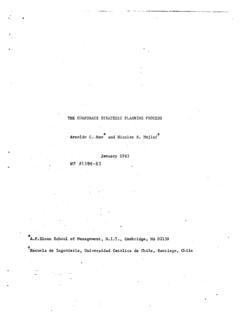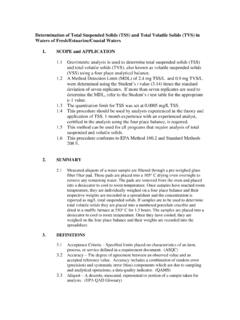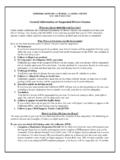Transcription of Design of Cable Systems for Cable Suspended Bridges
1 Design of Cable Systems for Cable Suspended BridgesbyJean-Pierre Michel Civil EngineeringAmerican University of Beirut(2000)Submitted to the Department of Civil and Environmental EngineeringIn Partial Fulfillment of the Requirements for theDegree ofMaster of Engineering in Civil and Environmental EngineeringAt theMassachusetts Institute of TechnologyJune 2001 Jean-Pierre Michel ChacarAll right reservedThe author hereby grants to MIT permission to reproduce and to distribute publicly paperand electronic copies of this thesis document in whole and in partsSignature of AuthorDepartm ent of Civil andEnvironmental EngineeringMay 22, 2001"ICertified bProfessor of Civil And/Jerome J. ConnorEnvironmental EngineeringThesis SupervisorI'rChairman, Committee forMASSACHUSETTS INSTITUTEOF TECHNOLOGYJUN 0 4 2001 LIBRARIESOral BuyukozturkGraduate StudentsERAccepted by/ZDesign of Cable Systems for Cable Suspended BridgesByJean-Pierre Michel ChacarSubmitted to the Department of Civil and Environmental EngineeringOn May 21,2001 in partial fulfillment of the requirements for theDegree of Master of Engineering in High Performance StructuresAbstractStructural Design requires a full understanding and knowledge of all the componentscomprising the structure.
2 The main element of a Cable Suspended bridge is the cablesystem. Special attention on aspects other than mathematical calculations should begiven. This thesis examines issues other than Design calculation in Cable Systems such asprotection of cables, fatigue and wind considerations and finally, monitoring Supervisor:Title:Professor Jerome J. ConnorProfessor of Civil and Environmental EngineeringTo my FatherAcknowledgementsMy utmost respect and gratitude to my father Michel who gave me theopportunity to advance in my studies. Without his support, all this would not have , my deepest respect and gratitude goes to my mother Hilda. Her moralsupport and continuous preoccupation gave me strength to persevere and go to the , I would like to mention my sister Sandra and brother Paul.
3 Thank youguys for you preoccupation and what follows, I would like to express my thanks to all who helped me indifferent ways during my thesis preparation and my academic year at and Foremost, my deepest gratitude to my advisor Professor Jerome who guided me during my stay at MIT and whose responsive feedback helped mein meeting thanks to Lisa Grebner for being so responsive and helpful in our and in my personal thanks to Cynthia Stewart for helping me out with all the official , a special thanks to my friends -Bass, Chris, Karim, Konstantinos, Todd-and other fellows students -Noelle, Yasmin, Nick, Bart- naming just a few, butall the other remain on my those whose names are present above and those who have not beenmentioned, thanks you for your moral support and your strong believes in you all -Thanks!
4 !!4 Table of Content1 Historical overview .. D ifferent kinds of cables .. Arrangem ent of cables in suspension Bridges .. Flat rectangular disposition .. A gglom eration of cables .. 173 Protection of Cables .. Physical dam Grouting .. Coating .. G alvanizing .. M ain Cable protection in Suspended Bridges .. Fretting ..214 W ind Consideration .. General characteristics .. Rain-wind oscillation .. W ind tunnel testing .. 245 Fatigue of A ctive Neuro-Control of Cable Vibration Using ER/MR Active tendon 297 Cable Observation .. Electrom agnetic inspection .. The Eddie Current M 3 The M agnetic Flux Leakage (M FL).. A coustic surveillance or m onitoring .. Ultrasonic testing method.
5 Vibration dynamic method .. Radiography .. 358 Conclusion .. 36 Reference .. 376 Table of Structural Strand .. Different types of structural ropes .. Parallel-bar Cable .. Locked-coil Parallel w ire Parallel strand Cable .. Mockup of the Golden Gate bridge main Cable .. 16 Fig. 8 Flat rectangular disposition of cables .. Rectangular arrangement of 18 Fig. 10 Hexagonal arrangement of 18 Fig. 11 Shock absorbers ..23F ig .12 C lam p .. 2 3 Fig. 13 Stress range versus N (for parallel wire and parallel strand).. 26 Fig. 14 Cables implementation of ER/EM dampers .. Active tendon control installed in the 29 Fig. 16 Magnetic Flux Leakage principal .. 32 Fig. 17 A one-second recording showing a wire fracture and background noise.
6 33 List of TablesTable Span of Suspension Span of Cable Stayed 2 Evolution of Cable IntroductionThe principle of carrying a load by suspending it to a rope or Cable has been utilized sinceancient times. But it was not until 1823 that the first permanent Cable supported bridgewas built in Geneva. Even though the span of the structures erected at the time was ofmodest dimensions, it was the start of a big impressive leap in bridge Suspended Bridges are innovative structures that are both old and new in are old in the sense that they have been evolving over a period of 400 years andnew in a way that these structures started to attract attention in the middle of the engineers started experimenting with the use of cables in Bridges , they met littlesuccess due to the fact that the statics were not fully understood and that unsuitablematerials were used [4].
7 Designing started on a trial and error basis and evolved , in our technical age with a well-developed infrastructure, computercommunication, heavy equipment readily available and a better understanding of thebehavior of such structures, Cable supported Bridges are becoming much more Cable supported Bridges provide useful data regarding Design , fabricationerection and maintenance of new Systems . As Bridges are being built, experience on thesubject is being gained, and longer spans are being and show the increase in the span of Cable supported Bridges (suspensionbridges and Cable -stayed Bridges ) over the years [5].Table Span (m) of Suspension Bridges Table Span (m) of Cable -Stayedbridges8 Year Name Span Country1903 Williamsburg 488 USA1924 Bear Mountain 497 USA1926 Benjamin Franklin 533 USA1929 Ambassador 564 USA1931 Georges Washington 1067 USA1937 Golden Gate 1280 USA1964 Verrazano Narrows 1298 USA1981 Humber 1410 England1998 Storebaelt East 1624 Denmark1998 Akashi Kaikyo 1990 JapanYear Name Span Country1969 Knie 320 Germany1970 Duisburg-N.
8 350 Germany1975 404 France1983 Barrios de Luna 440 Spain1986 Alex Fraser 465 Canada1991 Igushi 490 Japan1991 Kvarnsund 530 Norway1993 Yangpu 602 China1995 Normandie 856 France1999 Tatara 890 JapanThe key element for both Suspension bridge and a Cable -Stayed bridge is the Cable . Theevolution of these bridge types of was based on the development of Cable theory thesis will examine the main issues regarding cables. Starting with a generaloverview, this thesis discusses the main corrosion types and protection techniques used incommon practice. Some special Design considerations are presented (such as windconsideration and fatigue). Finally, Cable inspection techniques and the state of the art useof Active Control are CablesCables are the fundamental elements in Cable -supported structures.
9 For that reason,choosing among the different existing types requires special are usually made of high tensile strength steel wires having a diameter rangingfrom 3 general characteristics of the steel used [5]:" Yield strength: 1180 MPA" Tensile strength: 1570 MPA" Strain at breaking: 4%" Modulus of elasticity: 205 GPA" Chemical composition: C, Si, Mn, Cu, Ni, , P, steel has a much higher yield stress and tensile strength than normal steel used inconstruction (about five times and four times higher values respectively), but a muchlower ductility. Due to its high carbon content, this steel cannot be Historical overviewThe cables used in Cable -supported structures have the same composition of the cablesused in prestressed concrete.
10 There is similarity not only in the material properties, butalso in the physical aspect (different kinds of cables will be presented later on).Both types of cables have to sustain very high tension; in the prestressed concrete, thetension is used to keep the concrete always in compression, whereas in Cable -supportedstructures, the high tension result from the load transmitted from the structure it to thesupporting elements).The idea of prestressing main elements in a structure is very old. The Egyptians used to"prestress" the hull of their ships by cooling hot metal strips attached to concrete became known and applied due to the work of Eugene Freysinnet(French engineer 1879-1962) who is considered the "inventor of prestressing".

















